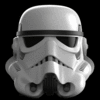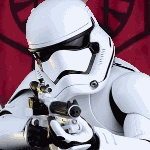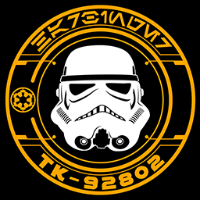Search the Community
Showing results for 'Isopropyl alcohol'.
-
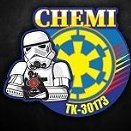
Tim’s first time build (RS Prop Masters ESB TK)
Chemi replied to TrickyT81's topic in ESB Build Threads
I've never used that glue, but I'm sure someone will be able to give you some advice. Maybe soaking it in warm water, or using isopropyl alcohol, or mineral spirits might help. What is very important, is that you don't use products with acetone. -
One thing other than mineral spirts that worked for my is isopropyl alcohol. You could try 70% before moving up higher to like 92%. Be sure the overpaint that you're trying to remove actually gets some of the moisture of whatever solution you use. I generally start with q-tips or some fine-tipped ones from a craft store. Think of them like a fine-tipped sharpie vs a regular one. They're absorbent, but tipped for precise application. Depending on how much paint I'm trying to remove, I may then use a toothpick to chip away at the paint, or stick with the fine-tipped swap.
-
Any bad side effects to using rubbing alcohol to shine ABS? It works great on scuffs, but if it accelerates yellowing or something else I’m unaware of... figured I’d ask the experts. Sent from my iPhone using Tapatalk
-
Wipe the insides with a clean rag. Get rid of that moisture, immediately! Clean with a soft washcloth and warm, soapy water if needed. Any liquid soap will work fine, I use dishwashing soap. Make sure everything is dry before storage. Cracks needs to be fixed as soon as possible. I use CA glue and spare pieces of plastics for a quick fix, and ABC paste made from spare pieces melted in aceton for a more permanent fix. If possible, repair from the inside. If the repair is visible on the outside, I sand it smooth with incrementaly higher grit sandpapers, and finish off with Novus polish. Scuffs is just battle damage and bonus weathering. It looks awesome (and movie accurate!) after a few troops. But if I want to shine, I rub away the scuff marks with an eraser, and then I wipe the armor with a soft cloth and isopropyl alcohol to get rid of any grime. I finish with Novus polish. Novus should work on all plastics, also PVC, but take a look at their website to be sure. It's novuspolish.com. Thighten all screws, nuts and bolts before storage AND before the next troop. Nothing is more annoying than losing a chicago screw on the holster in the middle of a troop. If you have an emergency repair kit (and you should!), check to see if you need to refill it. @Nairy: Yellowing has nothing to do with polish, but UV and heat. All white armor will turn yellow over time. Exposure to the sun will accelerate it, so do not store your armor near a window. I also advice against storing the armor near a heat source. But you can turn yellow plastic (temporarily) white again with a hydrogen peroxide and UV treatment. The tricky part is that it is difficult (and expensive) to submerge the armor in peroxide. The common way to solve this is to make a creamy peroxide gel to smear on the armor, that sticks to the plastic while the sun does its thing. Search "Retr0bright" for a recipe. Or get a ready-to-use mixture, like Trooperbay's ArmorWhite.
-

ANH Stunt "fitting/adjustment" thread (AP)
Doggydoc replied to BAZINGA's topic in ANH (Stunt and Hero)
Yes. I used industrial Velcro and sewed it to the elastic by hand. @revlimiter is correct in that you just need a band of it to still allow the elastic to work. The only issue I found with sewing is that if you use the self adhesive Velcro, the needle picks up the glue as it goes through and it gets very hard to push through because it gets sticky. You just need to have some isopropyl alcohol to wipe it as the glue builds up. At hi Val also helped a lot to save your finger pushing it through. It is not visible, so it does not need to look pretty. I will grab a photo and post it for you. -
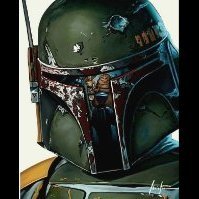
TK84215 requesting ANH Stunt EIB status (TM) (1041)
Lazerjock replied to Lazerjock's topic in Request Expert Infantry Status
I thought the frown might me boarder line. I'm on it! Thank you for the incredibly fast response too. I'll post new pictures of the frown as soon as I can. Most Likely this weekend. Do you recommend any paint remover. I read Isopropyl Alcohol, Mineral Spirits & Goo Gone will work. I have 90% Isopropyl Alcohol I use to clean my 3D printed resin parts. I will start with that. Again thank you for the compliments and quick response. Chris -
OP (MV) Post #48: Helmet Repainting In my previous build update I covered my initial painting of the helmet traps and tears, and while I was happy with the results of my tears, I was too heavy-handed with the paintbrush on the traps, and some paint wrinkling occurred. This update will include the following: Trap Repainting Frown Teeth Repainting Ear painting and Countersink Reinforcement Tips Helmet Interior Hardware Paint and Lens Polishing Faceplate and Cap Alignment (pre-attachment) Neck Opening Dimensions and S-trim Questions Upcoming Response to Comment Trap Repainting First up, repainting one of each of the rear and side traps. In both instances, I previously went too heavy with the enamel paint, resulting in some wrinkling. I was happy with the external profile and placement of the black "outlines" that I had painted before, so I decided to try to sand down the wrinkles on the grey, then repaint a second layer on top of the first one (as opposed to removing ALL the grey and black paint and starting fresh). Below is a photo progression of the process. First I put down two layers of tape around the perimeter of the sanding area in order to prevent scratches on the white ABS. Then I began with 220 grit sandpaper then worked my way to 600. I did not want to use any courser grit so as not to accidentally scratch too deep into the paint. After sanding I wiped the area clean with rubbing alcohol, removed the blue tape, then proceeded to hand-paint the gray portions again with Humbrol #5 gloss. Before painting the gray on the left-rear trap (which had been left black for the past year so that I could paint it at the same time as the right now) I also wanted to straighten out the bowed bottom edge that I had accidentally painted when using excess Trooperbay decal material as a template as documented in this post. Some blue tape, 91% isopropyl alcohol, and craft (popsicle) sticks later and I now have a sufficient bottom edge. On the right-side trap and the right-rear trap I also wanted to narrow the black outline, which essentially meant painting the grey out a little more. In order to minimize the first layer paint edge from creating a visible seam line on the new top coat, I sanded down the edges of the first coat to create a smooth gradient to the bottom black layer. I was also hopeful that the base layer of black underneath the new extended grey area wouldn't result in the grey appearing darker than the main center mass of the grey, and I think it looks just fine. The narrowed thickness of the black outline now better matches my left trap and the tears. With the base grey and black outline now complete on the rear traps, it was finally time to have a go at black vent lines. I decided to use the exact same strategy that I employed for my tears, using a TB masking template and sponge technique as documented by Cricket. Joseph also has a Template Painting 101 thread for those of you new to the craft. First I sealed the template with a thin layer of grey, and then I sponged on several coats of black. The top photos below show the state before cleanup with mineral spirts and toothpicks, while the bottom pair shows the initial final result. As can be seen when looking closely, this is where I ran into my first problem. Somewhere along the way I erred with paint thickness or drying time (I pulled the templates up within five minutes, which was surely too soon for drying), because when I pulled up the templates some of the painted extreme tips of the vents came up with them. After cleaning it up as best I could with mineral spirits, craft (popsicle) sticks, and toothpicks, I was still not satisfied, but I decided against free-hand painting the problem areas due to the finesse that would have been required. Unfortunately, in that moment I had to head off to work so I had to table the paint work and lose valuable cleanup TIME before the paint fully cured. After a day or two of deliberation busy life obligations I decided to try something crazy, which was to reuse the same already-used masking templates. Note that, at least back in 2020, Trooperbay included two sheets of each template, so technically I had some to spare, but I wanted to save my second set. Surprisingly, it worked ok, and though I did have to spend some time cleaning up paint that seeped under the template, I’m mostly happy with the end result, shown below. The first three photos show my process up close, first with what the reused template looked like before repainting, and then my cleanup tools (mineral spirts in a small bottle and DVI cable cap). This quad-photo below shows the traps before (left) and after (right) cleanup. It's not perfect, but I can live with it. In hindsight, I slightly wish I had used a standard template instead of "hand-painted" one, in order to achieve more uniformity. Frown Teeth Repainting I spent months debating whether or not to add more paint to the teeth, not due to the first coat being too light, but instead due to the teeth color stopping well before the gums. Essentially I was trying to decide whether the teeth needed more coverage, particularly at the bottom. In my heart I knew that answer was yes, but I was hesitant to potentially compromise the very smooth paint job I laid down with the first coat. I had certainly used borderline too much paint in order get a buttery smooth surface, but luckily didn't experience any wrinkling, likely due to there not being a concave surface for paint pooling (and instead a convex plane). This first triple-photo below shows the "before" state from my first found of painting a year ago. For a time I considered simply adding some paint at the bottoms of the teeth, but I knew I'd never be happy with a visible paint seam. I was also worried about a ridge at the edge of the undercoat being visible through the extended top coat. To test whether or not this would be an issue, I pulled out my trusty paint test strip of ABS that I'd used for various paint tests (paint thickness, opacity, finish, color, sanding, straight-line clean-up) in the past. I sanded down an edge of an old painted rectangle then painted a new later on top of both it and an un-sanded edge. Once it cured I noticed that a faint line of the bottom layer edge was visible in the top layer, which cemented my decision. To combat such a ridge I decided to very carefully sand down the edges of the original coat of teeth paint in order to create a more gentle taper to the unpainted portion of the teeth/gums (this was the same technique I used for my aforementioned fixed traps above). With edge sanding complete, it was time to dive into the new coat of Humbrol #5 gloss enamel. Rather than rely solely on and painting to masking tape like I did the first time, I elected to use a combination of freehand painting and masking this time, particularly since I know knew how easy it would be to clean up over-paint while it’s still wet. I decided to mask the tops of all except the center tooth since I wanted to maintain the top edge, and also added guide tape at the bottom of the teeth (shown in the before and after photos below) to mark the front edge of the frown curve. However, rather than paint to that bottom guide, I free-handed the bottom painted portion, ending well before the line. It was really more a point of reference. The goal of this repainting was to have a “full” frown when viewed from the front when previously some of the teeth looked like they were missing their bottoms. This before and after photo below shows the difference between post-sanding, after which a little bit of the edges of the teeth paint had been removed, and after they had been repainted. Notice how the paint extends lower, even compared to the very first photo in the triple-pane at the beginning of this teeth section. I think I succeeded in eliminating the appearance of white humps at the bottom of each tooth, as hoped for. The triple-photo below shows pre-cleanup teeth immediately after removing the masking tape, followed by larger images of my finished product post mineral spirit cleanup. I am now quite happy with the result. Ear Painting and Countersink Reinforcement While I had my paints out I thought I would also try my hand at painting the rank bar areas on my ears. I suspect that most builders usually do this after their helmet is assembled, but I wanted to take advantage of having the untrimmed ears sit flat on a table to maximize stability during the hand-painting process. I understood that I might make errors in my ear trimming so I painted all four of the ears that came with my ATA kit. Once I move on to trimming and sanding the ears I will cover up the painted area so as not to damage the finish during the constant handling and sanding process. Throughout my TK-building journey I’ve grown to appreciate the imperfections and abnormalities of this white armor, and one area I was intent on maintaining was the rectangular vs rounded edges of the painted ear areas. This was done very easily on my ATA armor and I essentially simply followed the form of the ABS. I laid down some masking tape on the four sides of each rank area then followed up my Testors 1139 semi-gloss black enamel paint application with some mineral spirit cleanup. I let the black layer cure for several days before returning with the Humbrol Gloss 5 gray enamel in order to allow me to clean up any mis-painting without impacting the black layer below. Similarly, I waited several days before returning to do the single black rank marking on each ear. Thoughts on my ear painting? For those of you interested in an alternative to painting these ear details, Trooperbay sells pinstripe tape and rank bar decals. Personally I almost caved on the rank bar lines since it took me three tries (wiping off the paint twice to start over) to get it to my liking. My method of paint application may have been a bit unconventional, using the large end of a toothpick and then cleaning up with the pointed end. Also related to the ears, a year ago when I used milliput for my hovi reinforcement and lens mounting I had some extra left over so I decided reinforce the inside of the ears where the mounting screws would need to be countersunk (for higher levels of approval). Here is what that looks like. Notice that in one ear I also painted over the milliput with Testors 1145 gloss white enamel, which apparently dried to a bit more of a cream color. I had planned to use that same paint for the various bits of armor hardware that needs to be painted, but not anymore. Instead I think I'll spray paint the screw heads similar to how Justin did it. Any tips on an appropriate white spray for the very cool white of ATA armor (I believe similar to WTF and AP)? I cannot stress this enough—NEVER EVER RUSH through paint application, or build steps in general. I've previously stated this advice in the past, but it's worth mentioning again. Your build is not a sprint; it's a marathon. In regards to paint work, if you have to ask yourself and deliberate whether or not you have enough time for preparation, application, and cleanup, then you probably don't. Take your time. Do things methodically. No shortcuts. Leave extra time to spar should something unforeseen arise. The context of this advice this time is that I rushed through my trap painting and didn't initially give myself enough paint clean-up time, and also cut it very close with my ear painting. Paint multiple thin layers. Every time I paint I keep attempting to walk a fine line between laying down barely enough paint for a smooth enamel finish, and too much which will result in wrinkling. In the past I experienced wrinkling twice while painting two of my traps, and this time I can extremely close with my ear painting. I applied just a little too much gray on my ears, which resulted in a few tiny pinholes (perhaps from air bubbles, which could have also been the result of poor paint stirring or brush technique). Interior Hardware Paint and Lens Polishing On my known to-do list was also painting the raw metal screw heads and washers inside my helmet so they would disappear into the rest of the black interior. I removed my lenses and hovi tips and sprayed the screw heads and exposed washer sides matte black, being careful not to paint the threading. I accomplished this by pressing them into a piece of cardboard to hold them steady and cover the threading. A long time ago I acquired some screw post covers, so after cutting them to length, they essentially black out the hovi posts. With the lenses off I also tried to polish them up since I scratched them up a bit while sanding the edges. At that earlier point in my build I didn't have any sanding experience and didn't realize how easily the lens material would scratch up. Using Novus 1 and 2 I was able to buff out some of the scratches, which I'm sufficiently happy with, but some do still remain. I used the Novus paper towels by hand, but would a polish drum for my dremmel provide a better solution? I have the three levels of Novus, but would another agent work better? Or perhaps I'd be better off sourcing some replacement lens material? The photo below shows pre-buffed lenses with tape covering the screw post holes to keep the Novus 2 paste from entering. Faceplate and Cap Alignment A long time back I had previously posted a mock-up for faceplate and cap alignment to inquire for feedback about brow height, but I wasn't yet ready to attach the pieces at that time, so we'll try it again now. Using Dan's excellent reference posts on helmet alignment and brow height, I set out to achieve proper alignment, with perhaps a slightly lower brow than the average Stunt trooper. I'll admit that I've always loved the menacing presentation of a lower Hero brow. So friends, what do you think of this? I'm sure @CableGuy has some thoughts, and I feel like I've seen @ABS80 comment on alignment in the past, though I admittedly am not working on an AP kit. I do know that some additional trimming around the edges of the pieces in the ear and neck area are still in order. The first quad-photo below, admittedly, utilized lights at a bad angle, so the brow looks deceivingly low due to shadows. The last photo provides a more accurate depiction. For attachment of the face and cap I'm intending to use two screws on each side, with washers and a regular nut. Would a locking nut or washer be better? I hope to place one screw somewhat between the top two ear-piece screws, and the other towards the bottom of the ear. I imagine this lower one should go above where the bottom ear screws in, correct, so as not to congest that area near the S-trim? Neck Opening Dimensions and S-trim Finally, in preparation for my helmet face/cap assembly, and ear trimming, I'm hoping to crowd-source some information on neck-opening sizes. I know that getting a helmet on often requires putting it on sideways then rotating, and that things can get tight quick, so I want to ensure I give myself enough room before making a final cut in my S-trim. Can any of you share measurements of how deep and wide your neck openings are, and what your recommendations would be for sizing? I'd hate to cut it too small then have to widen it up down the road and then have an insufficient length of S-trim. The first dual-photo below is an example photo of what I'm looking for, using a WTF bucket that I won from Stormtrooper Ranch last year (which has been helpful for hands-on observation). The second show my ATA faceplate next to the WTF. Are there minimum and maximum recommended opening sizes? As a reminder, this section contains all the questions I asked throughout the post, and sometimes also new ones which are generally listed first. I've always been hopefully that such a consolidation might increase the likelihood of them being remembered and answered. =) Are any improvements needed on my rear and side traps? Thoughts on my ear painting? Any deficiencies? Any tips on an appropriate white spray to match the very cool white of ATA armor (I believe similar to WTF and AP)? It seems both Testors 1145 and the Humbrol gloss white are both somewhat off-white. Would a polish drum for my Dremmel be the best solution to buff out scratches on my helmet lenses? Is Novus 1 and 2 the best buffing products to use on lenses? Would it be better to simply source some replacement lens material and cut new ones? What do you think about my faceplate and cap alignment? Is it ready for attachment? For attachment of the face and cap I'm intending to use two screws on each side, with washers and a regular nut. Would a locking nut or washer be better? I hope to place one screw somewhat between the top two ear-piece screws, and the other towards the bottom of the ear. I imagine this lower one should go above where the bottom ear screws in, correct, so as not to congest that area near the S-trim? Can any of you share measurements of how deep and wide your neck openings are, and what your recommendations would be for sizing? I'd hate to cut it too small then have to widen it up down the road and then have an insufficient length of S-trim. Are there minimum and maximum recommended opening sizes? Did you miss me? ;-) Not armor build related, but still relating to the hobby, do any of you have suggestions for a chrome spray paint? Faceplate and cap attachment (screws) Ear trimming and fitment Neck opening sizing and S-trim installation Tube stripe painting My completed ATA helmet build vs the WTF TK/TD I won from Stormtrooper Ranch And there we have it. My first real update in nearly a year. Here's to progress, and rebuilding momentum to continue my build and journey to the 501st! As a reminder, a specially-formatted (not just a webpage printout) downloadable PDF of my entire build thread to this point is contained in [THIS SHARED FOLDER]. The PDF will be updated within a day or two of my own new posts and will note sequential version numbers and revision dates. Additionally, I've now revisited all my previous posts on this build thread and updated (reduced) the image widths where single rows of two to four images bled onto a second row due to a narrowing of the whitearmor webpage to accommodate the activity column last year. In a web browser this thread should now display as originally intended. Bill @CT 1977 - Thanks for your kind words; I'm glad to hear my content has been helpful to you! Trooperbay is definitely still up and running, though ironically I faced a similar access challenge when attempting to navigate to the site from work. I think some filters block the site, and certain browsers might display security certificate issues. But Trooperbay is definitely the place to go, and this masking template link is working for me right now, as is the other one that Chemi linked to. You may also try utilizing a different device, such as a tablet or phone, if you've been on a computer.
-
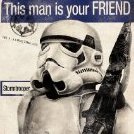
Toothdoc's Armor Master v4.5 Helmet Build (Rookie Trooper))
Toothdoc replied to Toothdoc's topic in ESB Build Threads
The next series of photos show a problem I had battling that HUGE ear area gap on the right side of the helmet. I thought I should have a much better fit similar to what I got with the left side. So, being the perfectionist, I answered the call to fix it somehow. I just wanted a better fit before I started on the ears. I first tried using a hair drier to soften the plastic and work the area down somewhat. After darn near burning my fingers, I just wasn't getting any resolution to my efforts. So my next approach to this was to drill another hole just below the top edge of the tube area and try to add another screw to this area pulling the gap a little tighter. For some reason I grabbed a 4-40 socket head bolt, a couple of washers and a T-nut to do the work. I got my hole drilled and added the fasteners. I then thought I'd be smart and put a little dab of blue (removable) LocTite thread locker on the tee nut. The gap was somewhat smaller and I was pretty smart, or so I thought. I left my work area for a short break and came back and GASPED! WTF?!? (except I didn't say Walt's Trooper Factory) The tiny amount of LocTite I had applied had gotten onto the ABS, softened it somewhat and now the area was CRACKING under the stress of the bolt I had just installed to help close the gap. YIKES! I quickly disassembled the helmet and thoroughly cleaned off the LocTite residue with a paper towel and some handy isopropyl alcohol. DANG! What had I just done? The left hole in the photo below was the site I drilled and applied the LocTite on the tee nut. One cn clearly see the fractured areas. First, I cleaned (scraped) the area on the interior aspect of the helmet free from paint and down to bare plastic. I carefully ensured that the cracks were positioned back together and were flat, especially on the outside of the helmet. I then got a piece of 0.7 oz fiberglass cloth and cut out a patch about 1" x 2" and tried it over the area for effective coverage. I mixed up a small amount of my trusty JB Weld Plastic Bonder epoxy. I then smeared a fair amount on the bare plastic with a popsicle stick and spread it out in a thin manner. The fiberglass patch went over this and I used my finger, first dipped in the isopropyl alcohol to work the fiberglass cloth into the epoxy and smoothed out the final surface. I used care not to over use the alcohol, just enough to keep my finger wet and have less sticking to the epoxy. I let the entire thing dry for about 24 hours before returning to evaluate it. Upon later inspection, the repair seemed very strong and quite well mended. My goal was to eliminate any further propagation of the cracks and keep it together. My efforts seemed to have done a good job. I used a sharp #11 blade and trimmed the remaining glass cloth from the edge of the plastic. I touched up the black paint with some Testors flat black and a model brush. I reassembled the helmet and just didn't worry about placing a bolt back in the same area as before. I was decided to leave the area alone and just use the right ear to do my best and cover the area. Something I should have just done all along! Moral of the story is that these things DON'T FIT TOGETHER VERY WELL and the ears will most likely cover a lot of the crazy gaps well enough. I don't believe its an AMv4.5 helmet thing, but a TK bucket design thing. Lesson learned! -
I used mineral spirits for the gray paint to remove it and isopropyl alcohol for the blue paint.
-
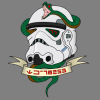
TKSnake's ANH TK Repair & Electronics Tutorials
TKSnake replied to TKSnake's topic in Tutorials, Tips and HOWTOs
Soldering 101 If you've always wanted to get into soldering your own electronics for cosplay but have never picked up a soldering iron before, I've created some tips on how to do basic soldering, based off my personal experience on doing soldering as a hobby and for the US Military. The Basics of What You'll Need: Soldering Wand or Station Soldering sponge or metal tip cleaner Solder Flux Soldering Clamps (like Velleman Helping Hands) Isopropyl Rubbing Alcohol An old toothbrush Assorted wiring shrink wrap If you'd like to know more, please read on. Soldering Irons Cheap soldering irons can get your foot in the door. As long as it can melt solder, you have something you can work with. Simple soldering wands are the main way people do soldering. However, if you want to get into good soldering, a solder station will be a better option for a number of reasons, but most importantly because: Soldering stations have a built-on solder iron holder. You don't have to worry about dropping your iron, which can be dangerous and cause bodily harm or damage property. Most stations have a sponge holder, which is important for cleaning the iron and making clean solder welds. You can control temperature. Soldering wands always operate at full power, meaning that tips wear down faster due to oxidation; plus, there's a higher possibility of damaging components at high power, especially when soldering on Printed Circuit Boards (PCBs). Soldering stations typically have a temperature dial. For about $30 - $50, you can get a decent soldering station with adjustable temperature. For example, the Weller WLC100 is a great beginning soldering station, doesn't cost much more than a stand-alone wand, and includes a sponge and temperature control (my non-endorsed, honest opinion). Tips are more expensive than budget tips, but rightfully so - they'll last longer than budget tips too, especially if you use my Best Practices tips below to help ensure their longevity. When I was in the USMC, I was trained on Pace PRC-2000 workstation. I'd love to have one since it does soldering, paste dispensing, has a de-soldering vacuum, etc., but as they cost over $5000 they're a but out of my price range at this time Types of Solder Electronics work is done with solder, which is a blend of tin, nickel, and sometimes a touch of lead to lower the melting point. Typically, I use standard 60/40 (60% tin / 40% nickel) solder with a rosin core. For health issues, ironically, lead (if using leaded solder) isn't as big of a fumigation problem as the rosin flux inside of the solder, since lead doesn't boil off until it reaches ~2000 degrees F (most soldering is done only at ~400 - 500 degrees F). Rosin helps the solder adhere and melt, but is a sticky, tarry substance that can build up in lungs over time, like tar from cigarettes. Make sure to solder in a well ventilated area, and blow fumes away from your face when soldering. Most solder has a flux core to help with solder jobs. For electronics jobs, we use rosin flux, NOT acid flux (which is used in plumbing). You can also use solder without flux, and use extra flux instead (which is what I personally do). Look below for more info on flux. Flux Most beginning soldering jobs fail because they don't use extra rosin flux. I can't emphasize how important flux is in creating strong, clean solder joints. Although there's typically flux already on many solders, extra flux can really help solder a joint together. Flux cleans any oxidation and helps lower the surface tension of the solder, so it can better permeate the solder joint and create a strong weld. Just a small dab per joint is all you need. It does leave a sticky film afterwards, which you can clean up using my Clean-Up tips below. Best Soldering Practices When soldering, using the following steps help ensure a clean, strong soldering joint: Apply solder to the joint, NOT the iron. Apply flux to the joint, heat up the joint with the soldering iron, and add the solder to the hot joint. Using clips can help keep joints stationary while soldering, especially when soldering two wires together, for example. This leaves your hands free to apply flux, the soldering iron tip, and solder. Keep your soldering iron clean. Before you start a solder joint, run the tip of the iron across your wet sponge quickly to remove oxidation. Always use non-abrasive methods to clean your iron to ensure the nickel outer shell lasts as long as possible. Prevent tip oxidation. While your iron is idle, tin the tip with some solder to protect it against air, which causes oxidation. Turn your iron off if it's going to be idle for longer than a few minutes. Replace your tips as necessary. Over time, the end of the tip will become irregular, as the outer nickel outer shell wears off and the tip's iron core is exposed, which oxidizes and wears out faster. When this happens, you should discard and replace the tip. Otherwise, your solder jobs will start getting chunkier and chunkier, leading to bad joints and faulty circuits. Solder Joints Tinning Whenever you solder stranded wires (wires made of smaller wires, like in most flexible wiring, it's important to tint eh end of the wire. This is done by applying some flux and then soldering the end of the wire with a hot iron and some solder. Tinned wires are easier to work with, and provide a little extra solder when soldering the wire to a board or another wire. Hook Joint When soldering wires together, one technique you can use is a hook joint. It's easier when using helping hands but can be done also via gravity (dangling one wire from the other during soldering) so long as there's no weight load on the wires. Tin the end of both wires to be joined If the joint will close the connection, remember to slide shrink wrap down the wires to be shrunk later Use a needle-noise pliers or round pliers to create a u-shaped hook on the end of each wire Hook the wires together, and crimp the hooks on top of each other Apply flux to the joint, then solder with a hot iron and solder Apply shrink wrap to cover the solder joint Butt Joint Butt joints are harder and require your clamps or helping hands to hold both ends of the wire together during the solder weld, but are sometimes necessary when wires are close together or you want to keep shrink wrap from bulging to make installation wire mesh or the wires themselves easier. It's similar to the above procedure, but with fewer steps. Tin the end of both wires to be joined If the joint will close the connection, remember to slide shrink wrap down the wires to be shrunk later Use the helping hands to place the end of one wire on top of the end of the other wire Apply flux to the joint, then carefully solder with a hot iron and solder without disturbing the placement of the wires Apply shrink wrap to cover the solder joint Through-Board Joints For Velleman MK136 and other solder kits, your solder joints will be through-board; that is, the component leads will go through the top of the board, and soldered on the bottom of the board. When doing through-board soldering, remember to get your components set up first and trim as much of the lead off as your' comfortable with (using masking tape to hold components to the board while soldering also helps). put on some flux, and get the hot iron to touch both the lead and the pad before adding solder. Remember to only use as much solder as necessary to connect the lead to the entire circumference of the pad. Surface Mount Soldering Surface mount components are what most modern PCBs use, wherein micro-miniature components are soldered onto the top of the board, typically using wave soldering, or paste soldering and heat guns. These are advanced manufacturing techniques and not currently part of this how-to post. De-soldering If you need to de-solder, such as removing pre-fab components from a PCB or correcting a mistake (like soldering an LED backwards), de-soldering is typically done in two ways: Wicking braid: This is copper broad that is placed on top of a soldering joint. A hot iron is placed on top of the braid, which wicks up the solder as it melts, like a paper towel. The braid can get hot during de-soldering, so take care to not get burned. Solder vacuum: While liquefying the solder joint while applying the iron, a small vacuum is placed near the joint. When the button on the vacuum is pressed, the vacuum engages and suck up the liquid solder. Although this method doesn't require any disposable braid, I find it less useful than braid personally. Some high-end soldering stations include a de-soldering tool, which is essentially an iron with a hollow tip which acts as a vacuum. However, these stations can be quite expensive. Insulation and Shrink Wrap When you're soldering wires together, it's important to add shrink wrap to each conductor so your wires don't short out. Think carefully when soldering, as often times you'll need to apply shrink wrap before you solder, since you won't be able to add it after the solder joint is made. You can shrink wrap with a heat source, like a lighter or heat gun. The former works well enough, but remember to move your heat source around while shrinking to avoid charring the wire or shrink wrap. Heat guns work better in this case since they are less likely to char. Use shrink wrap just large enough for the job, to ensure it shrinks to a nice, snug fit. For some joints, you might need two different gauges of wrap - a larger one to cover the joint, and another to place over the end of the larger gauge, to shrink it more snug to the wire insulation. Clean-Up On the soldering kits and larger jobs, you'll want to remove excess flux with isopropyl alcohol and an old toothbrush or disposable towels. Alcohol cleans up the stick flux residue without corroding or damaging the components. An old thrombus is stiff enough to scrub off the flux while gentle enough to not damage your components or solder joints. Clean your soldering iron sponge or tip cleaner after your soldering sessions. You don't want to get old solder back on the tip while you're trying to clean it. After everything else is clean, remember to clean your hands. Flux is a stomach irritant and can lead to GI discomfort. Like your solder projects, you can clean flux from your hands with some rubbing alcohol and light scrubbing, and good 'ole soap. More Information: You Tube: How to Solder (from CuriousInventor) -
OP (MV) Post #40: Additional Helmet Resources + Intro to the Ears & Brow + First Hand Painting I've had these ears in-hand for over half a year now, but never until now did I fully realize just how differently shaped the left and right are from each other. I knew everything was asymmetrical, and Alexey's photo captures it [im]perfectly, but wow this lid is wonky. The ear photos below really highlight the profile differences. Here is a supplemental list of resources for all things helmet-related which will guide my work in the next several posts. I will likely reference and link to individual techniques in my next several updates, but this is the entire collection. HELMET BUILDS pandatrooper's ATA Brow & Ear Section (Print entire thread PDF) Ales ATA Ear Section by Ales (Print entire thread PDF) ANH TE2 Helmet Build by TK-4510 A.J.'s Helmet Work kman's Lens Mounting Posts LTM Lens Mounting, and Helmet Work Cricket's Sponge Template Painting and Lid Work (several posts) zv288bot's Helmet Assembly, Scimitar's Excellent Helmet (Pages 1-3) wook1138 Helmet Progress Ensi's Helmet Work dereferenced's Photo-Heavy Posts plus Flickr album TheLorelei's Helmet Posts (across many pages) HELMET TUTORIALS Quick Reference Guide OT TKs by justjoseph63 (see particular posts) (Print PDF) Helmet Ear Tutorial by gazmosis (Print PDF) Draw No Gap Ear Line by bpoodoo (Print PDF) Choose Your Brow Height by CableGuy (Print PDF) Helmet Alignment by CableGuy (Print PDF) Template Painting 101 by justjoseph63 (Print PDF) HELMET VIDEOS Video of panda's finished ATA helmet Video tutorials by TK-4510: Helmet Assembly series, Hand-Painting TE2 series, How To Apply Decals CableGuy's TM Series & supplemental Stormtrooper Series RS Prop Masters RWA's Lid Build (2-part series), General Assembly Overview, and Hovi Tip Fitting Pandatrooper's series Armor Building with TK1636 Before proceeding with additional cap side trimming in preparation for ear fitting, I decided to try a few things which aren't completely conventional―the first being to paint the front traps before locking in the brow height and ear placement. My goal with this was to enable me to fine-tune the precise location and cut angle at the ends of the brow trim, which I wanted to line up perfectly (to the extent possible) with the rear edge of the traps paint. Here are some example of what I was aiming for. With that goal in mind, I began by first finishing the trimming of the helmet cap around the ear area. As suggested by Terry (Panda) and many other Troopers, I drilled holes in the corners where the cut lines would meet to avoid any possible tearing. I believe I used a smaller drill bit than most but I wanted to create a tighter gap in those corners to help keep the brow trim wedged in and less susceptible to drooping. With the holes in place I proceeded to trim the remaining ABS with curved lexan scissors. I also decided not to sand any of the brow bottom edge in order to maintain just that little bit of extra "bite" from the roughness, which might potentially hold the brow trim in place better. I then set out to tackle my first hand-painting of my build, and used an uncommon (to my knowledge) technique to accomplish it. Because I have absolutely no experience in miniature or hobby painting, I wanted to us a stencil, and the decal sheet I originally purchased from Trooperbay seemed to fit the bill. Using an xacto blade, I sliced off the excess adhesive layer and test fit it to my ATA helmet LEFT trap. Seeing that this makeshift stencil was slightly too wide for my trap recess, I sliced the sticker so I could overlap the two pieces and thus shorten the total width. I then marked the helmet with a pencil where I wanted the outside edge of the black paint to be (the photo below shows draft marks which I eventually widened) and set the stencil. In an attempt to combat paint bleed under the stencil I pressed it down repeatedly with my fingernails (@justjoseph63 recommends a pencil eraser), and then further expanded the masking area with blue tape. Having already wiped down the ABS surface with isopropyl alcohol prior to laying down the stencil, I then proceeded with a thin laler of Testors 1145 Gloss White (purchased at Michaels or Hobby Lobby) along the edge, to try to seal any gabs under the stencil and prevent the forthcoming black paint from bleeding. I then followed it up with the appropriate Testors 1139 Semi-Gloss Black, also from Hobby Lobby. I applied first a thin coat followed quickly by a thicker coat without any wait time, so essentially only one coat, and below are my results. Note that the white paint photo was from my second (right) trap inserted in this process photo to show my actually sequencing. On the first (left) trap I left a little curved portion at the bottom covered by the stencil, but didn't use any white paint in that area as a test to see if "sealing" with the white actually does anything. The answer―it didn't really provide any benefit in this particular instances, but it can't hurt, so I will continue to use the strategy in the future. I will fill in the black in that remaining white area at a later time, even though it will eventually be covered by the brown trim, because you know, OCD. A couple other notes regarding painting. First, I absent-mindedly hand-shook the small paint bottles, rather than stirring them, but I don't seem to have introduced air bubbles into my paint job. Or maybe I did, and my inexperienced eyes simply can't discern them. To be on the safe side, next time I will stir them, perhaps with a folded up paperclip to create a whisk of sorts. I also failed to remember that enamel paints dry far slower than latex home wall paint, and that I therefore should have let both the white paint and masking stencil sit longer prior to proceeding/removing. I only waiting maybe five minutes between the white and black paint, and pulled off the masking perhaps only five minutes painting. Luckily I don't think this impacted my results, and the end photo above is without any cleanup. I wonder if I should take my chances and replicate my exact same process again, or pivot to the apparently more tried and true methods. Perhaps some qualities of the TB decal cutout I used (adhesive on the bottom and smooth on bottom?) were beneficial? Apparently I pretty much ignored Joseph's painting guide―not intentionally of course, but from lack of memory and not having it right in front of me to reference. That's what I get for using my ancient iPad to review RS suit and reference JoeR images for trap sizing, my printed binders stuck in another room, and working in my baby daughter's nursery closet at 5:00am. Instead of using two thin layers I applied a single thick one. Luckily only a thin outline of the black will remain visible once I go over most of it with gray. But don't be like me. Be like Joseph (and other veterans), and use his Paint 101 thread, which I've now linked to five times in this post for emphasis. Haha. So with lessons learned, the following day I proceeded with the right-side trap. Even though I was successful with my technique from the first trap, I decided to employ at least some of the advice mentioned above. I stirred the paint with a toothpick and waited half an hour after applying the thin white edging before moving to the black. But of course I then fell back to my success from the previous day and only applied a single thick layer of black, and also removed the stencil after only 5-10 minutes of "drying" time. Basically the enamel paint was still very wet when I removed all the masking, but thankfully once again I was blessed with very good results, at least to my eyes. At this point I realized I had a little warp on the right-side of the brow near the trap and wished I had tried to smoothen it out a bit before applying the black paint. I read that enamel paint isn't as flexible as acrylic, and since I didn't want to risk cracking my fresh paint job, and had no prior armor and paint experience to inform me of whether or not it might actually occur, I proceeded with conservative caution. The arrows below show all the areas that I would have liked to apply some pressure to fix the curvature, but I decided to work on only the green areas in order to avoid bending the painted area. Not wanting to risk over-heating with a heat gun, I decided that boiling water was my only option, but I also didn't want to just dip my lid into a pot, or even pour boiling water on that entire area due to the paint in close proximity. Instead, I dipped a white cloth into the water, pressed it against both side of the plastic, and simultaneously applied pressure in the proper areas. I did this repeatedly with fresh rounds of boiling water (while wearing thick protective gloves), but in the end I'm not sure it made any difference. I suspect I simply wasn't raising the temperature of the ABS enough. But it was worth a shot, and I'll now simply rely on the brow trim to cover this odd curve. I'm sure this imperfection is more screen-accurate anyway. With the traps painted (black only; gray to follow later) and cured it was time to fit and slice the brow trim. I tackled one side first, using needle files to shift the trim back as far as needed to align with the traps (first set of photos below). Once I had that side flush and the trim cut at the appropriate angle I turned my attention to the other end, which I knew would be a bit more difficult to align properly due to my method. With the trim installed on the brow I eyeballed where I thought I'd need to cut and made a series of three conservative cuts to finally attain the proper length. Due to perspective challenges with the trim bent away from its final resting location, I actually got lucky with my final cut, thinking I'd have one more to make. Fortunately, I didn't overcut, and here were my results: I was extremely luckily with my third slice on the trim, which was still a cut of about 1cm, since I thought I had more material to work with. I had expected to need at least one or two more cuts getting down to 1-2mm, but the rounded ear section of the cap through off my estimates. In hindsight, perhaps a better way to cut the trim CLOSE to the final length would have been to remove the trim completely, tape it onto the front of the brow, and mark and cut accordingly. It could then be test-fitted and retrimmed as needed. The photo below shows both methods. Now on to a preview of my potential brow line and the current status of my cap and face plate alignment. I've always like a low brow, but I do also want to stay somewhat true to the common Stunt alignment, since that's what I'm building. Hopefully this isn't too Hero-like, though I know it's nowhere near Luke's level. Now that I think about it, I'm tempted to lower it further... And of course the seams/alignment under where the ears will be placed are all crazy. I trimmed back a little more plastic to get the pieces to fit well together. It looks like I could attain a better pairing of the two pieces by trimming more of the cap on the wearer's RIGHT side. Would you all agree? Should I also raise the rear of the face plate a bit more (but keep the front at its current height) to further reduce the gap along the tube bulge? This would result in the brow trim not being perfectly parallel with the tops of the eyes all the way around, but even screen references I see show the brow-eye gap narrowing on the sides near the ears. As I've often done, here is a review of the questions already asked throughout this post: It looks like I could attain a better pairing of the two [helmet] pieces by trimming more of the cap on the wearer's RIGHT side. Would you all agree? Should I also raise the rear of the face plate a bit more (but keep the front at its current height) to further reduce the gap along the tube bulge? This would result in the brow trim not being perfectly parallel with the tops of the eyes all the way around, but even screen references I see show the brow-eye gap narrowing on the sides near the ears. Finally, as you've likely noticed, I've updated my method of displaying photos in my posts. With less than 300 uploads left on my limited Flickr account, I am attempting to conserve capacity by combining images in collages. However, since many mobile collage apps downscale images, I'm using my 10-year-old Photoshop (and desktop computer for that matter) to manually compose the collages with each individual image segment retaining its original resolution (4,032 x 3,024). This means that my collages are quite dimensionally large (some over 12,000px wide) so they can still be zoomed in on for closer inspection. As is always the case, I try to display images in my posts at 800px (or 400px) in width so they don't visually weigh down the post and so viewers will lower-resolution monitors can hopefully see them entirely without lateral scrolling. Note: I want to continue to use Flickr, rather than imgur, in order to keep my image collection on a single platform, and since I like the organizational features of Flickr. I'm also starting to add some additional graphics to my posts, mainly for format and aesthetic purposes. Hopefully they are a positive addition to my documentation and don't detract in any way. That's all for this update. The time for ear trimming is soon approaching... Printable/downloadable PDF of my entire build thread to this point contained in [THIS SHARED FOLDER]. The PDF will be updated within a few hours of my own new posts and will note sequential version numbers and revision dates.
-
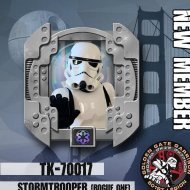
DarthBiscuit's R1TK Build (Jimmiroquai kit)
DarthBiscuit replied to DarthBiscuit's topic in Rogue One Build Threads
So I got A LOT done today, not many pics, since most of it was touching up things you wouldn't notice without being inches away from it... I first tried rubbing compound to blend in the white parts that were taped with the untaped white parts that I sprayed a few extra coats on. That didn't really help. So I gently sanded with 1,000 grit and then buffed it again. That helped a little, enough that I think it's good enough to move on. Then I used my Sharpie extra fine point oil-based paint markers to touch up the outlines. The markers performed HORRIBLY. Paint just wasn't coming out of the 1st marker, so I opened a 2nd. This worked for most of the outlines, except the rear trap that screwed up before. I saw videos that recommended soaking the tips in isopropyl alcohol to clean them out, but I don't have any readily available. So I opened a 3rd marker... This one was doing well, but just couldn't get into the rear trap's crevice. So I taped off around the crevice, and used a brush to apply paint from the 1st marker that I poured onto a plate. It worked lol! Moving on... I CAREFULLY drilled holes for ukswrath's hovi tips, starting with a small bit and working bigger to ensure I stayed perpendicular. That worked! I popped them in and am so happy! Didn't get a pic before I took them out though... Then, I put some E6000 across the top and the middle prongs of Jim's vocoder and stuck it on. The bottom prongs aren't touching at all. Does anyone see any issues with this application, or Does it look fine and will be acceptable? I put 2 magnets on top and 2 underneath to hold it still while curing. -
WhiskeyScroggins ANH Stunt Build - Anovos
WhiskeyScroggins replied to WhiskeyScroggins's topic in ANH Build Threads
Spent some time on the Anovos helmet today, and think I got it to a place I'm happy with. I knew I'd need to update the ear screws, remove some over spray, add in the outer teeth, and paint the inside of the hovi mic tips based on all the reading I'd done. I decided not to mess with the ear position as just too many things could go wrong and my understanding it this doesn't need to be done to meet Centurion. Here's what I did and the final product: First, updated the ear screws. The ones on the left are the new ones, the ones on the right were what came in the helmet from Anovos (these were repurposed to the TD as mentioned earlier in the thread). Painted them white and good to go: Next up the eyes: First I trimmed them back (forgot a before picture) to clean them up as Anovos had left a lot of extra in there! Next I made templates of each eye using an index card and tracing from the outside. I added about 1/4 inch around the trace line and cut the lens from the supplied Anovos one. Using the Sugru method as described by @justjoseph63 in his "how to" thread, I used white sugru to affix the lenses to the helmet. The sugru seems really strong so I didn't complicate it by adding any screws, etc. as I've seen some others do as this seems like it will hold just fine. Since I'd bought the combo black/white pack of Sugru, I used that to attach the frown as well. Next I replaced the Anovos mic tips. I was going to just paint the inside, but I knew I was eventually going to get the speaker mic tips from @ukswrath so just went ahead and did that now. Super simple. Quick unscrew of the Anovos tips, widened the mounting hole with 1/4 drill bit, and popped the new ones right in. 5 min tops, and they look great. Finally, cleaning up the teeth. This was the part I wasn't looking forward to. I masked each tooth off with painters tape and used a Qtip and isopropyl alcohol and just rubbed gently until it was gone. Had a couple areas to touch up and added the two outside edges to the frown (I actually like it better without them but I suppose accurate is accurate) and now I believe the helmet is complete! -
Let me be clear, I am an Imperial Cadet in the process of my first build (AP ANH Hero) trying to keep as close to centurion guidelines as possible. I've done 7 months of research through these threads to come to this point. I am not applying for initial application or status at all as my job keeps me out of the country and on the road way too much to do a troop. I'm just an enthusiast, I'm only making my armor to eventually ship home, set up on a manniquin, and eventually wear to the occasional costume party. During my build, like many young troopers out there discovered that nothing sticks to silicone! However being a fairly capable chap, I did some digging and found a relatively cheap solution. This solves the problem of having to apply cotton duck or canvas to the back of hand plates. However if nomex flight gloves are being used do remember to use wax paper on the inside of the glove so as not to fully seal your glove! Specifically for centurion approval (with ukswraths permission of course), I have found two adhesives that specifically work for fixing silicone hand plates to rubber gloves. Both products come in volumes large enough to supply a whole garrison with centurion gloves Links provided: Sil-poxy (Aerospace/Automotive industry standard) https://www.smooth-on.com/products/sil-poxy/ Permatex (cheaper of the two) https://www.permatex.com/products/adhesives-sealants/sealants/permatex-clear-rtv-silicone-adhesive-sealant/ Materials: - 220+ grit sandpaper - dishsoap - isopropyl alcohol - paper towel - latex/nitrile gloves - Permatex RTV Silicone Adhesive/Silpoxy - Clamps Procedure: (1) Scuff mating surfaces lightly with a fine grit sandpaper. (2) Clean and dry surfaces making sure that there is no contaminents, if desired wipe surfaces with isopropyl alcohol. (3) Apply a moderate amount of adhesive to hand plate, making sure to leave room for squeeze-out. (4) Immeadiatly assemble and clamp glove assembly for one hour. For the purposes of weathering these products will not accept most paints so do care to wipe away any excess. Full cure in 24 hours. CAUTION Both products contain hazardous materials that may cause irritation to skin and eyes. Do not mix these two products as there may be a hazardous reaction, exothermic or otherwise. Do exersize caution while handling adhesives to avoid contamination. Ensure adequet ventalation is present in addition to wearing safety glasses and nitrile gloves while applying adhesive. I hope this helps! Cheers
-
It is difficult to remove super glue from armor. That's why I prefer to use a rubber-based glue like E6000. Acetone is often used to remove super glue, but this WILL melt plastic. Do *NOT* use on armor. Hot water is a possible method. Be careful, though. You don't want to warp the plastic. I have previously used isopropyl alcohol with some luck. It is a solvent, and doesn't (shouldn't) melt the plastic. Try it on a safe spot first just to make sure. You'll also have to pry and scrape and work it. Just take your time. Oh, and as for extra cover strips, you could get this from many suppliers. I'm sure WTF have them if you ask, but it's just flat white ABS, not specific to the maker. I got mine from Trooperbay, but any smooth white ABS sheet with the correct thickness will suffice. Check your local hobby shop, hardware store, Amazon/Ebay.
-
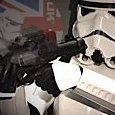
CableGuy’s HDPE ANH Stunt helmet (DA PROPS)
CableGuy replied to CableGuy's topic in ANH (Stunt and Hero)
More progress. As well as tidying up the teeth, the first two coats of oxide red primer are on. After a quick wipe down with some isopropyl alcohol, two coats of paint around 10 minutes apart. -
If you hit the search button you'll find quite a few threads on it's use, having a quick look there doesn't seem to be any negative comments that I have seen https://www.whitearmor.net/forum/search/?q=Isopropyl alcohol
-
Sometimes they have some in it, but mixed with all kinds of other junk. We just buy it at the drug store, usually. It's often in the first aid section, as it is often used as a topical antiseptic. It's also sometimes in the makeup aisle, since ladies sometimes use it for makeup removal. https://www.chemicals.co.uk/blog/uses-of-isopropyl-alcohol Some paints it's very effective at removing, but other kinds of paint might need something stronger.
-
Agreed. Most paint should be able to be removed with isopropyl alcohol, some cotton balls, and some elbow grease. It won't damage the plastic. (Since I was painting the same color over it, I didn't bother to go farther, but I certainly could have)
-
I would start with isopropyl alcohol, many paint thinners contain acetone which will dissolve ABS.
-
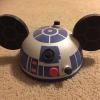
CptCasey's ANH Stunt Build Thread [MTK]
CptCasey replied to CptCasey's topic in Build Threads Requireing Maintenance
Question: I have the snaps with Tandy stamped onto the snaps. Since I'm aiming for centurion, do I need need to get different snaps for the posterior and the abs that don't have writing on them? Source for good quality snaps like that in the US? Family in town this week, so I didn't get a lot done. Glued the latex handguards to the rubber gloves. The Loctite Plastic Bonding System worked really well. Sanded the back of the guards and the gloves a little bit to at a little texture and cleaned with alcohol. Used the pen on both surfaces and then added glue the guards and attached. They set almost instantly. After a day of curing they seem to hold strong. Also taped up my bucket for platidip. Bought some white oven bake modeling clay for $1 at Walmart to put in the teeth. Plastidip is still curing, but I think it went well. Plan on cleaning up any overspray with isopropyl alcohol or mineral spirits. -
Hi all, New to the forum, after years of stumbling across useful info as I drifted in and out of my life-long obsession with Stormtroopers. :-) As a kid, my brother and I always wanted to be Stormtroopers. Whilst searching the net over 12 years ago, I spotted a couple of UKG TKs at a show of some sort - in the background was a banner for SDS Props.... and so it began. It wasn't long before I purchased my 'Stunt' trooper, number 330, and collected it in person from AA. This was later joined by the Tie Pilot and matching busts for both. Sadly, the years took their toll on Stormie and he started to yellow. So, after umming and arring for ages on what I should do, I attempted selling through a well known auction site - but nothing. So, I carried on researching and came across Mike (from Trooperbay)'s YouTube videos. Renovation time: I started by removing all of the decals, then carefully disassembling the helmet. You can clearly see the high level of discolouration, specifically under the tube stripes and brow. From this point, and following advice from this very forum, I sourced the paints, ordered the relevant templates from Trooperbay, and started prepping for paint. One cleaned (isopropyl alcohol), I was ready for primer. I went for Halfords (UK) white primer. The first coat was very light. Second coat helped to tame the yellow. Being very new to spray painting, I read that I should sand this down a little to take the rough surface away. 600grit sand paper. Here are four stages of prep: I was happy with the primer surface. I went for Halfords Appliance gloss white (as suggested by a few members) and started with coat one. Now, I'll admit that I didn't rewatch the tutorial before this part so wasn't intending to spray, leave for 5/10mins, second coat, leave for 5/10mins etc. As such, I was not getting even results and applied too much paint at one point, giving an undesirable 'tear' under his right eye. So, tried again, this time trying to improve my spray technique. Results were average, now with a tear on the rear, the right tube and an uneven coverage. So, went back and rewatched Mike's tutorials. Sanded down the whole helmet, cleaned up again ready for painting. Then, third can of spray paint and much better time keeping. First coat: Second coat: Final coat: For my first attempt at spray painting, learning how to work with the paint, getting the paint to the right level just before it runs, I'm really happy with the glossy finish. Now just need to find the time to start hand painting all of the details. TBC [emoji1] Sent from my iPhone using Tapatalk
-
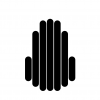
ANOVOS TK (discussion forum)
themaninthesuitcase replied to ukswrath's topic in ANH (Stunt and Hero)
Is the thinner enamel or acrylic based? I've also seen someone used rubbing alcohol on the Facebook group, as a non American is this the same as Isopropyl Alcohol? -

Mat's ANH stunt TM 2mm ABS
ozzytrooper replied to ozzytrooper's topic in Build Threads Requireing Maintenance
Decided not to redo the left ear going to leave it as it is ( well maybe just a little bit more trimming ) Moved onto cutting out the right ear and that took about the same time. No photos of the finished ears on the helmet, still not sure if I am done trimming. One of the rewarding things about doing a project like this is discovering the nuances like how different the left and right ears are or the unsymmetrical face plate, you don’t pick that up watching the movie. As a break from the ears fitted the split rivets in the kidney and ab plate. The rivets got a coat of primer and white from a spray can. The Hovi mix tips appear to be resin casted so gave them a quick clean with isopropyl alcohol before paint. Costume reference library states “black or painted black” and after looking at some reference photos decided to leave the very front and inside the original cast colour so masked off the mesh and front with some masking tape. Couple of coats of rustoleum satin black and the tips are done. On to the helmet accent painting. Originally was going to use decals and even purchased a set but decided to paint it by hand. The worst that can happen is I stuff it up in which case can put the decal over the top. Before painting marked up some reference lines with a pencil, this is the Vocoder but did the same with the Traps, ears and frown. Humbrol Black (No. 21) the vocoder, trap borders and ears. Humbrol Grey (No. 5) on the frown and traps, no reference line for the grey on the trap instead just tried to keep the black line about 1.5mm thick. Photo of the frown half done. Second coat of Grey done. Still to do are the Blue tube strips, vertical Black lines on the traps and rank stripe on the ears. -
Rubbing alcohol is sometime used for paint removal on model kits and won't damage plastics Sorry bad info on my part .But ipa( isopropyl alcohol) is definitely what I have used to remove paint from model kits before ,though to be fair that is styrene not abs.


